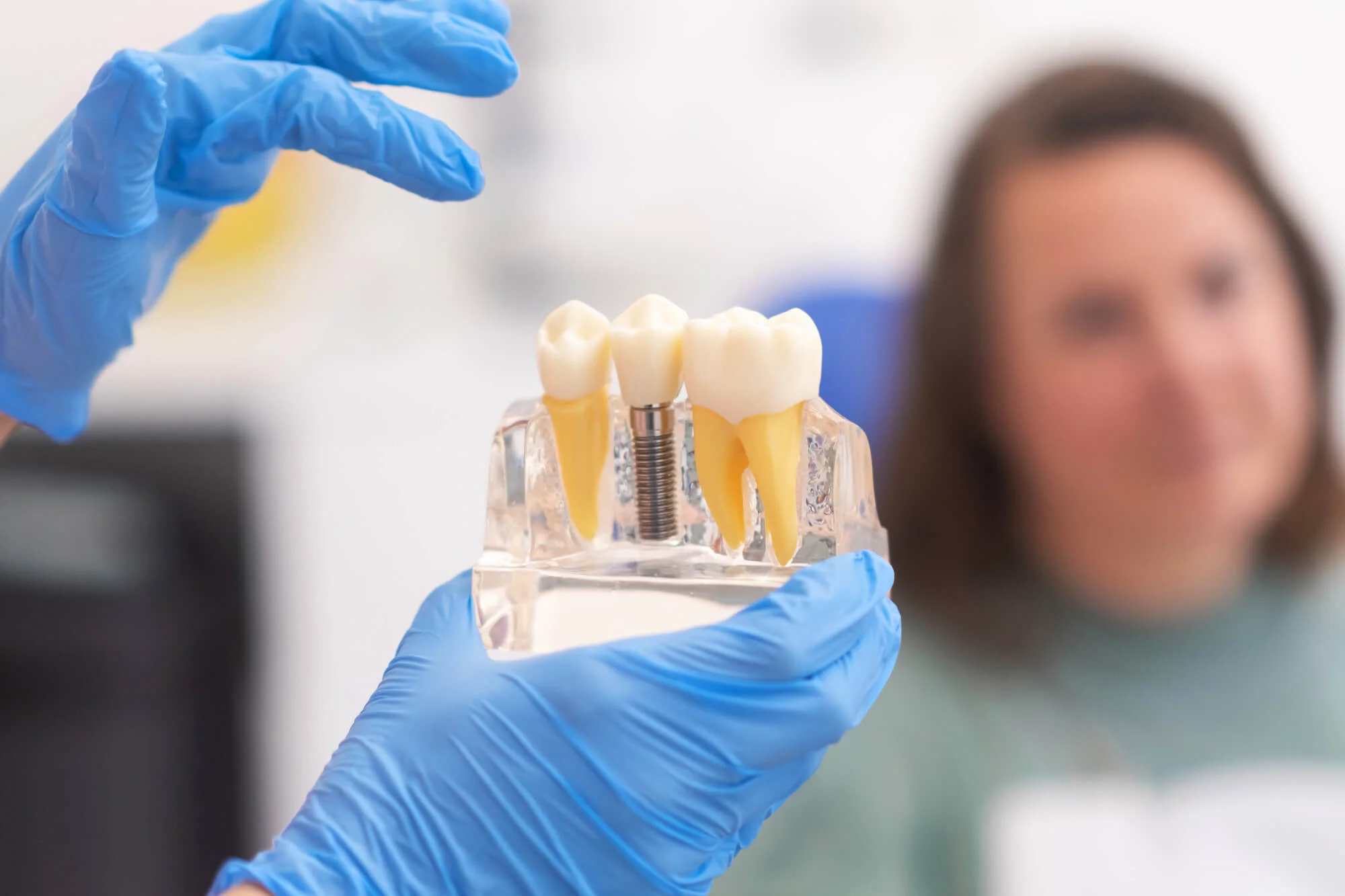Dental implants can feel intimidating—not because of the results, but because of the unknowns. If you’re considering a dental implant, one question probably tops your list: “How painful is this going to be?” It’s a fair concern.
This permanent solution to missing teeth is a long-term investment in your smile, but fear of pain or a tough recovery can make patients pause. The truth is, modern implant procedures are more comfortable than most expect, and with the right support, the healing process can be smooth and straightforward.
Let’s talk pain, healing, and what you can realistically expect when getting dental implants near you.

What to Expect: Is Getting a Dental Implant Painful?
The idea of a dental implant might conjure up images of drills, stitches, and soreness. But with modern techniques, anesthesia, and skilled professionals, most patients report less discomfort than they expected.
A dental implant procedure involves inserting a titanium post into your jawbone. This might sound intense, but the process is often easier than a tooth extraction. Local anesthesia numbs the area, and if you're anxious, sedation options are available to help you stay relaxed.
During the Procedure
Most patients feel pressure, not pain. Local anesthesia completely numbs the area, and sedation dentistry can help you remain calm and unaware of time passing. Patients often say the worst part was worrying before the appointment, not the procedure itself.
The procedure itself typically lasts between 30 and 90 minutes, depending on the number of implants. It's efficient and often done in a single visit.
After the Procedure
Once the numbness wears off, it's normal to feel mild to moderate discomfort. Think of it like a deep bruise or a pulled muscle. Most patients say it’s very manageable with over-the-counter pain medication.
You might also notice:
- Swelling near the implant site
- Minor bruising on the gums or jaw
- Slight bleeding within the first 24 hours
These side effects usually subside within 3–5 days. It’s rare to need anything stronger than ibuprofen or acetaminophen, though your dentist may prescribe something in specific cases.
How Long Does the Pain Last?
The most noticeable discomfort peaks within the first 48 hours after surgery and should gradually lessen each day.
Timeline of Recovery Discomfort
Day 1–2:
- Expect tenderness and swelling
- Use cold compresses and prescribed pain relief
- Stick to soft foods
Day 3–5:
- Pain should be significantly reduced
- Swelling begins to fade
- Most patients return to work or their daily routines
One Week and Beyond:
- Gums begin healing over the implant
- Discomfort is minimal
- You may forget you even had surgery
One Month Later:
- The implant is integrating with your jawbone
- No pain, no sensitivity—just waiting for your permanent crown
If pain persists or intensifies after a week, contact your provider. It’s rare, but lingering pain could indicate infection or implant issues.
Managing Pain Before, During, and After Your Implant
Knowing how to manage the discomfort before it begins is half the battle. Here's what we recommend.
Before Your Appointment
- Discuss your concerns with your dentist. Anxiety management starts with a clear plan.
- Ask about sedation options such as nitrous oxide or oral sedatives if you’re especially nervous.
- Eat a light meal (if not sedated) and stay hydrated.
- Arrange transportation if undergoing sedation.
During the Procedure
- Most implant procedures are completed in under 90 minutes.
- You'll receive local anesthesia and possibly sedation so that you won’t feel pain.
- Trust your provider—they’ve done this hundreds (if not thousands) of times.
Aftercare and Home Remedies
- Ice packs: Use intermittently for the first 24 hours to reduce swelling.
- Over-the-counter pain relief: Ibuprofen or acetaminophen is usually enough.
- Soft diet: Stick to smoothies, soups, and soft foods for a few days. Avoid crunchy or spicy foods.
- Saltwater rinses: After 24 hours, gently rinse with warm salt water to keep the area clean.
- Hydration and rest: Drink plenty of fluids and avoid intense exercise for 72 hours.
Understanding the Healing Process: What’s Happening Beneath the Surface
While most of the discomfort happens in the first few days, your body is doing some amazing work behind the scenes. Understanding this process can help ease your mind and give you a better appreciation of the journey to full recovery.
Osseointegration: The Foundation of Implant Success
After the implant is placed, your jawbone begins a process called osseointegration. This is when bone cells grow around the titanium post and lock it in place. It typically takes 3 to 6 months, but it’s completely painless during that time.
This process:
- Anchors the implant securely like a natural tooth root
- Prevents jawbone loss that occurs with missing teeth
- Prepares the site for your permanent crown or prosthetic
Tissue Healing and Gum Health
Your gums also need time to heal. They’ll begin to contour around the implant naturally, creating a healthy seal that protects the site. Good oral hygiene is essential during this phase to prevent infection and inflammation.
Long-Term Comfort
Once the implant is fully integrated and restored with a crown, it will look, feel, and function like a natural tooth. Most patients forget they even have an implant—it becomes a seamless part of their smile.
How Much Anxiety Is Normal?
It’s more common than you think. Dental anxiety affects over 36% of Americans to some degree, and implant procedures can heighten those fears. But knowing what’s ahead helps reduce that anxiety.
Here’s What Helps:
- Patient education: Understanding the step-by-step process helps reduce fear of the unknown.
- Pre-op consultation: Ask all your questions. No concern is too small.
- Sedation options: From nitrous oxide to IV sedation, your comfort is a priority.
- Personalized care: The dental team tailors every implant experience to you, not just your teeth.
Common Myths About Implant Pain
Let’s debunk a few myths that cause unnecessary worry.
MYTH #1: “Implants are more painful than extractions.”
False. Many patients say implant surgery was easier than a tooth extraction, especially with no post-op throbbing.
MYTH #2: “Recovery takes forever.”
Healing happens in phases. Discomfort usually fades within a week, while the bone fuses over 3–6 months.
MYTH #3: “It hurts when the implant fuses to the bone.”
Nope. Osseointegration (when bone fuses to the implant) happens silently beneath the surface. You won’t feel a thing.
MYTH #4: “You can’t get an implant if you have bone loss.”
Also false. Techniques like bone grafting make implants possible even after bone deterioration.

Are You Considering Dental Implants Near You?
It’s okay to be nervous. Pain is a natural concern, but in reality, dental implants hurt far less than most expect. The benefits—confidence, function, and a healthy smile—far outweigh the brief discomfort.
When seeking implant dentistry, choose a practice that combines precision with compassion. At Mirror Lake Dentistry, we use advanced technology, sedation options, and personalized treatment plans. We focus on partnering with you throughout the process, from consultation to the final crown. Patients appreciate feeling heard and supported.
If you’re ready to restore your smile with dental implants, contact Mirror Lake Dentistry today to schedule your consultation.


